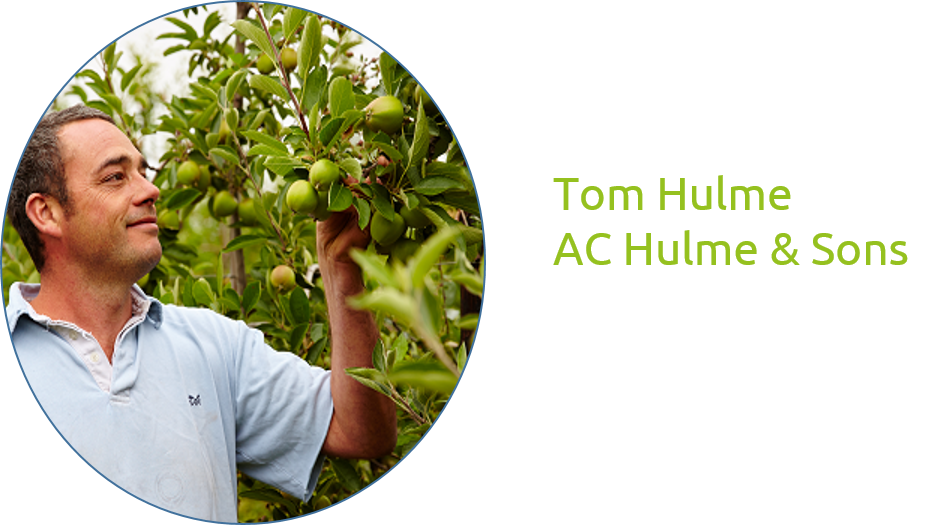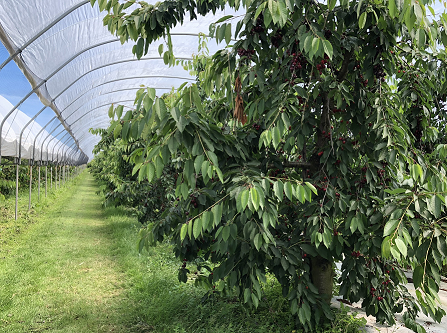Please click here to access the main AHDB website and other sectors.
Stopping spotted wing drosophila
Tuesday, 8 December 2020
AC Hulme & Sons is a family-owned, mixed farming business, based in Kent. Tom Hulme manages their 400-acre tree fruit business. Tom explains how he has worked with AHDB to tackle spotted wing drosophila, one of the biggest threats to the UK fruit industry.
About AC Hulme & Sons
- Family run business spanning four generations
- 4,000 acres in East Kent
- Crops: cereals, potatoes, hops, single suckle beef cattle, biomass and tree fruit
- Tree fruit business:
- Grow and pack cherries, plums, apricots, apples and pears
- 400 acres
Why is spotted wing drosophila a problem for the UK fruit industry?
Spotted Wing Drosophila (SWD) is an invasive fruit fly of soft and stone fruit crops. It can result in complete crop loss if left untreated, and the value of British fruits rendered unsaleable as a result of SWD damage is estimated at £162m per year.
While SWD arrived in the UK in 2012, it was only experienced for the first time by AC Hulme & Sons two years later. Tom explains, “We first experienced commercial SWD damage in our cherry crop in 2014. We have a relatively late site due to the delaying plastic we use to cover our cherries, and we lost over a third of our crop.
“It was economically damaging to our business that summer, as we not only lost revenue but also had no work for our seasonal staff for a three-week period, which led to significant costs in finding other work for them in order to retain them in our business to harvest out top fruit crops.”
For A C Hulme & Sons, working closely with AHDB and the SWD steering group was going to be important to help them manage this new pest.
“We focused very clearly on all options for controlling the pest in 2015, and I began to engage very closely with the researchers at East Malling. This ultimately led to taking a position on the Tree Fruit Panel and direct involvement in the SWD research programme,” said Tom.
Making changes to control SWD
So how has this research changed how A C Hulme & Sons grow their crop?
Tom explains, “There has been a huge and impressive amount of research undertaken on behalf of the industry to determine how to control this damaging pest, and this has very clearly driven decision making on my farm.
“Since 2014, we have experimented with all available options to control the pest, but our efforts have since focused on three clear aspects.
“Firstly, all of our cherries are grown under plastic covers with SWD insect netting around the outside, which limits the population inside the orchard. AHDB shared research findings that helped us determine the minimum size of mesh to use as we were very concerned about airflow reduction leading to rotten fruit.
“Secondly, we implement a strict orchard hygiene regime seeking to remove all fruit from the orchard as we undertake the harvest. This is costly and frustrating for our staff but is clearly important.
“Finally, we closely follow the AHDB recommendations with regards to the timing and application of control products, including extending our spray intervals as a result of work undertaken by NIAB EMR on our farm, investigating the control period of Tracer and Exirel in 2018 and 2019.”
Securing plant protection products for SWD
Our crop protection team work closely with the industry to secure Extensions of Minor Use Authorisations (EAMUs) for the control of SWD. In 2020, we were successful in obtaining seven successful emergency authorisations including Benevia 10OD, Exirel 10SE and Tracer for a range of soft and stone fruit crops.
For Tom, these authorisations remain critical in the fight to control the pest. He argues, “It is clear that there is no silver bullet with SWD and the many actions we take in our business (for example, use of insect netting, orchard hygiene, trapping to guide pest levels, etc.) have led to a satisfactory level of commercial control of the pest since 2014.
“But chemical control (based around Tracer and Exirel which are both subject to recurring annual emergency authorisations) is the most important aspect of these efforts. I feel strongly that without this wide-ranging approach, we would not be able to achieve commercial control on our farm.”


What is AHDB doing to tackle SWD?
Over the last eight years, we have invested significant resources to help growers understand SWD; from tips on how to monitor for the pest, to ways of managing population build-up and advice on the most effective crop protection products to use for control. As Rachel McGauley, AHDB Crop Protection Scientist explains, the research has already delivered significant outcomes for levy payers, and there is more in the pipeline.
Using the extensive monitoring dataset we have developed, we are creating models to predict key life-stages, such as when egg-laying females emerge, based on environmental data. Initial results are promising, and we aim to have a tool available for levy-payers soon
We have been trialling the use of bait sprays in combination with chemical control products with promising results. Not only can the use of a bait spray be considerably less expensive than the use of full-rate plant protection sprays, but it can also provide the same control with 96% less control product, offering some exciting environmental benefits and a reduced risk of fruit residues. Initial results also indicate the flies die quicker when the plant protection product is applied with a bait spray which helps prevent resistance developing. We are currently investigating ways of securing approval for the use of bait sprays
A push/pull system is where a grower uses repellents within the crop to push the pest to the perimeter of the crop, in combination with an attractant with a killing mechanism around the crop boundary. This is a work in progress, but we are excited by developments so far with this IPM compatible control strategy
We are investigating the use of precision monitoring techniques in woodlands, with traps to catch and kill overwintering flies. We hope that by targeting this vulnerable life stage when the flies are not reproducing, we can decrease the number of flies going into the spring and delay the build-up of the population
The repeated use of a limited number of plant protection products could result in resistance developing in the UK, as it has in the USA. We are monitoring for signs of this happening here
The future of SWD research
Our future focus will be on the most promising areas, such as bait sprays, winter control and developing a push/pull system. The Crop Protection team will continue to support growers with applications for EAMUs and emergency authorisations. In SCEPTREplus, we’ll also be looking at finding egg-laying deterrents.
Tom adds, “There is a lot of work still being undertaken on behalf of the industry, and I am privileged to have the opportunity to feed in my views on which direction this research takes as a result of my position on the Tree Fruit Panel”.
“Many of the workstreams are exciting, particularly the various bio-control options that are being pursued”.
“However, my focus remains on available chemical actives. These are currently highly-dependent on EAMUs and emergency authorisations, and the length of period they offer control, which can be significantly affected by all sorts of factors such as climate, sunlight and humidity. This is an area I am very focused on understanding better.”

